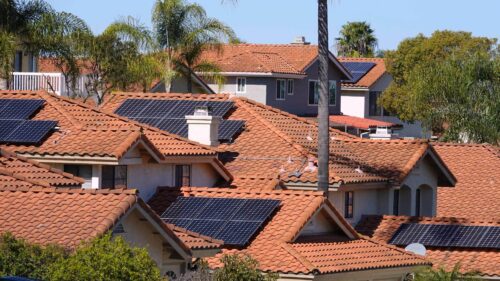Buyers of electric vehicles (EVs) face tighter financing terms compared to those who buy conventional, non-EV vehicles in Europe and in the US, according to a recent paper by experts at Wharton and the University of British Columbia in Canada, titled “Financing the Global Shift to Electric Mobility.” While the paper documents EV financing trends in Europe, subsequent research by the authors revealed similar patterns in the US as well.
The authors found that EVs, compared to non-electric models in the same car family, are financed with higher interest rates, lower loan-to-value ratios and shorter loan durations. That “financing gap” occurs because lenders price in the risks they perceive in obsolescence caused by rapid advances in EV technology, the paper explained.
“Our paper is the first step towards understanding financing barriers to EV adoption,” said Wharton finance professor Huan Tang, who co-authored the paper with University of British Columbia finance professors Jan Bena and Bo Bian. The paper noted that in discussions around the global transition to electric mobility, there is a lack of emphasis on the significance of consumer financing in EV adoption.
What causes the EV financing gap
The study showed that the primary driver of the “EV financing gap” is the technological risk associated with EVs. Lenders charge higher interest rates on EV loans because “the rapid and uncertain evolution of EV technologies accelerates technology obsolescence, diminishing the resale value of EVs,” the paper pointed out. The tighter financing terms for EVs have little to do with consumer demographics, lenders’ market power, or macroeconomic factors, it added.
EVs are an important part of the transition from traditional fossil fuels to clean energy, Tang noted. “However, during this transition period, the battery technology associated with EV innovation has not matured yet, which means the current generation of battery may become obsolete very quickly, maybe in one or two years,” she said. “Existing batteries have insufficient capacity and charge slowly, leading to unprecedented amounts of public and private funding being allocated to advancing battery technology research and development,” the paper pointed out.
The residual value of EVs is an important aspect of understanding lenders’ behavior. Lenders would get possession of the cars they finance either in the event of repossession if borrowers default, or at the end of a lease term. But the rapid development of EV battery technology could lower the market value of their EV loan portfolio.
“There’s also a lot of uncertainty in how much lower that market value could be, because we don’t know when the next generation of better technology will be born and commercialized,” Tang said. “So, to price in that risk or to cope with that risk, lenders charge a higher interest rate. They are passing through that risk to the household.” In vehicle leases, the study found that lenders attribute lower residual value estimates to EVs at the commencement of a lease.
In addition to technology risks, the paper listed other factors that might contribute to the high financing costs of EVs. Those include the potential of a default risk for EV loans; a relatively lower demand sensitivity with respect to price where buyers are willing to pay a higher price for their loans; and possible differences in lenders’ market power in the EV vs. non-EV loan market segments. “[But] these alternative explanations account for either little or only a small fraction of the EV spread,” the paper stated.
Key findings: EV vs. non-EV financing
The study used data covering 15 million car loans in 11 European countries, between January 2010 and August 2021 and securitized by European lenders. It focused on 10 brands of manufacturers that make both EVs and non-EVs: BMW, Ford, Honda, Hyundai, Lexus, Mercedes, Peugeot, Toyota, Volkswagen and Volvo.
Analysis of that data revealed “a systematic gap” in the financing terms between EV and non-EV models within the same car family, across different lenders, different car makes and different countries. Specifically, the gaps were as follows:
- The interest rate on EV loans was 0.29 percentage points higher than that for non-EV loans, representing 6.5% of the average interest rate of 4.5% in the study’s sample.
- The loan-to-value (LTV) ratio for EV loans was 4.7 percentage points lower than that for non-EV loans, which meant that EV buyers had to make higher down payments than non-EV buyers. The loan component in EV loans was 6.7% lower than the sample average of 70%.
- The third difference was a 2.5-month shorter loan maturity for EV loans than that for non-EV loans. It was also 5.4% lower than the sample average of a little over 46 months. The average loan size was 13,890 euros (approx. $15,000).
Citing prior research, the paper noted that consumers are “highly sensitive” to both the prices of vehicles and the financing terms offered by auto loans. “[Notably], consumers mention a lack of affordability as the primary concern when considering the adoption of EVs,” the researchers added.
The authors measured the risks associated with EV-related technologies in terms of both “intensity” and “dispersion” of innovations by analyzing trends in patent awards and venture capital investments. They gauged the “intensity” of relevant battery technology innovations, based on the number of patents granted, the importance of those patents and the dollar value of VC investments in EV-related startups. The “dispersion” aspect captures the uncertainties about the directions of future advancements in EV and battery technologies.
Next, they devised a metric they called the “EV spread” to measure how innovations in battery technology impact interest rates. They found that a higher level of their measures of the intensity and dispersion of innovations in EV-related technologies is associated with a larger EV spread. A one-quartile increase in the intensity of clean patenting widens the EV spread by 0.148 percentage points, the paper stated. Similarly, a one-quartile increase in the dispersion of battery-related technological directions widens the EV spread by 0.136 percentage points.
Conducive policy environment
The policy push for EVs is unambiguously encouraging in both the European Union and the US, as the paper noted. The EU in 2023 adopted a law that requires carmakers to achieve a 100% reduction in CO2 emissions from new cars sold by 2035. That would effectively prohibit the sale of new fossil fuel-powered vehicles in the 27-country EU bloc. The law also calls for a 55% reduction in CO2 emissions for new cars sold from 2030 compared to 2021 levels.
In the US, the Biden administration has set a goal of EVs accounting for at least 50% of all new vehicle sales by 2030. Toward that end, through its EV Acceleration Challenge initiative, it has issued a “call to action” to support that goal to the private and public sectors, including advocacy and community groups.
The Biden administration has attempted to ease the financing burden for EV buyers. Taxpayers who buy an eligible vehicle may qualify for a federal tax credit of up to $7,500, according to a Department of Energy note. That breaks up into two credits of $3,750 each for vehicles that meet the critical mineral requirements and those that meet the battery component requirements; vehicles meeting both conditions are eligible for the total tax credit of $7,500. Various states also offer their own incentives to boost EV adoption; the DoE periodically publishes updates on state-level incentives for EVs.
The paper noted that while most policy discussions focus on the affordability of EVs in terms of their purchase price, less attention is paid to the role of consumer financing of EVs. “Our research fills this gap and can inform public policies that aim at making EV financing more accessible,” the authors wrote.
“Along the whole supply chain, we have subsidies for the production and purchase of EV cars, but we have not seen any intervention related to the financing part,” Tang said.
[Knowledge at Wharton first published this piece and is a partner of Fair Observer.]
The views expressed in this article are the author’s own and do not necessarily reflect Fair Observer’s editorial policy.
Support Fair Observer
We rely on your support for our independence, diversity and quality.
For more than 10 years, Fair Observer has been free, fair and independent. No billionaire owns us, no advertisers control us. We are a reader-supported nonprofit. Unlike many other publications, we keep our content free for readers regardless of where they live or whether they can afford to pay. We have no paywalls and no ads.
In the post-truth era of fake news, echo chambers and filter bubbles, we publish a plurality of perspectives from around the world. Anyone can publish with us, but everyone goes through a rigorous editorial process. So, you get fact-checked, well-reasoned content instead of noise.
We publish 2,500+ voices from 90+ countries. We also conduct education and training programs
on subjects ranging from digital media and journalism to writing and critical thinking. This
doesn’t come cheap. Servers, editors, trainers and web developers cost
money.
Please consider supporting us on a regular basis as a recurring donor or a
sustaining member.
Will you support FO’s journalism?
We rely on your support for our independence, diversity and quality.










Comment